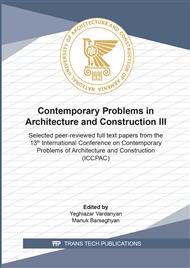[1]
A.A. Askadskii, YU.I. Matveev, Himicheskoe stroenie i fizicheskie svojstva polimerov // M.: Himiya, 1983, p.248.
Google Scholar
[2]
A.A. Askadskii, V.I. Kondrashchenko, Komp'yuternoe materialovedenie polimerov. T.1. Atomno-molekulyarnyj uroven' // Izd-vo Nauchnyj Mir, 1999, p.543.
Google Scholar
[3]
A.A. Askadskii, Computational Materials Science of Polymers // Cambridge International Science Publishing Ltd. Cambridge, 2003, p.695.
Google Scholar
[4]
A.A. Askadskii, T.A. Matseevich, M.N. Popova, Vtorichnye polimernye materialy. Mekhanicheskie i bar'ernye svojstva, plastifikaciya, smesi i nanokompozity // M.: Izd-vo ASV, 2017, p.490.
Google Scholar
[5]
L.V. Gurvich, G.V. Karachencev, V.I. Kondrat'ev and etc., Energiya razryva himicheskih svyazej. Potencialy ionizacii i srodstvo k elektronu // M.: Nauka, 1974, p.351.
Google Scholar
[6]
A.A. Koptelov, Teplofizika vysokih temperature // Vysokomolekulyarnye soedineniya, Seriya A, T.42, № 2, 2004, p.307.
Google Scholar
[7]
A.A. Koptelov, YU.M. Milekhin, O.F. SHlenskj, Teplovye effekty termicheskogo razlozheniya polimerov // Vysokomolekulyarnye soedineniya, Seriya A, T.47, № 9, 2005, pp.1628-1634.
Google Scholar
[8]
M.A. Villetti, J.S. Crespo, M.S. Soldi, A.T.N. Pires, R. Borsali and V. Soldi, Thermal degradation of natural polymers // Journal of Thermal Analysis and Calorimetry, V. 67, 2002, 295-303.
DOI: 10.1023/a:1013902510952
Google Scholar
[9]
A. Lafuma, D. Quere // Nature Materials, Vol. 2, 2003, p.457.
Google Scholar
[10]
A. Tuteja, W. Choi, M. Ma, J.M. Mabry, S.A. Mazella, G.C. Rutledge, G.H. McKinley, R.E. Cohen // Science, V.318, 2007, p.1618.
Google Scholar
[11]
Marius C. Costache, Dongyan Wang, Matthew J. Heidecker, E. Maniasa and Charles A. Wilkie The thermal degradation of poly(methyl methacrylate) nanocomposites with montmorillonite, layered double hydroxides and carbon nanotubes // Polym. Adv. Technol, T.17, 2006: p.272–280.
DOI: 10.1002/pat.697
Google Scholar
[12]
A. Kulkarni, H. Dasar, Current Status of Methods Used In Degradation of Polymers: // MATEC Web of Conferences №144, 2018, p.02023.
DOI: 10.1051/matecconf/201814402023
Google Scholar
[13]
A.A. Askadskii, A.I. Barabanova, E.S. Afanasev, N.D. Kagramanov, N.E. Mysova, N.S. Ikonnikov, E.P. Kharitonova, B.V. Lokshin, A.R. Khokhlov, O.E. Philippova, Revealing defects hampering the formation of epoxy networks with extremely high thermal properties: Theory and experiments // Polymer Testing, V. 90, 2020, p.106645.
DOI: 10.1016/j.polymertesting.2020.106645
Google Scholar
[14]
G.E. Zaikov, Gorenie, destrukciya i stabilizaciya polimerov // S.-Peterburg, Nauchnye osnovy i tekhnologii, 2008, p.424.
Google Scholar
[15]
A.K. Mikitaev, M.Kh. Ligidov, G.E. Zaikov, Modern tendencies in organic and bioorganic chemistry. Today and tomorrow. // N.-Y., Nova Science Publishers, 2008, p.428.
Google Scholar


